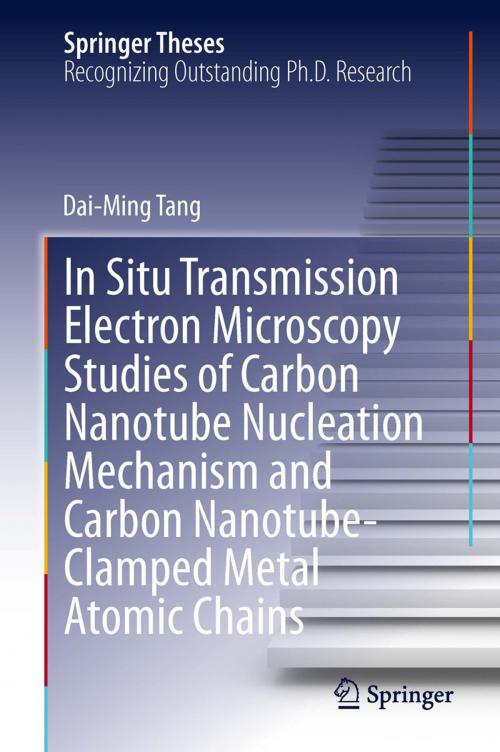In Situ Transmission Electron Microscopy Studies of Carbon Nanotube Nucleation Mechanism and Carbon Nanotube-Clamped Metal Atomic Chains
Nonfiction, Science & Nature, Technology, Nanotechnology, Material Science| Author: | Dai-Ming Tang | ISBN: | 9783642372599 |
| Publisher: | Springer Berlin Heidelberg | Publication: | July 8, 2014 |
| Imprint: | Springer | Language: | English |
| Author: | Dai-Ming Tang |
| ISBN: | 9783642372599 |
| Publisher: | Springer Berlin Heidelberg |
| Publication: | July 8, 2014 |
| Imprint: | Springer |
| Language: | English |
Using an in situ transmission electron microscopy (TEM) approach to investigate the growth mechanism of carbon nanotubes (CNTs) as well as the fabrication and properties of CNT-clamped metal atomic chains (MACs) is the focus of the research summarized in this thesis. The application of an in situ TEM approach in the above-mentioned research provides not only real-time observation but also monitored machining and structural evolvement at the atomic level. In this thesis, the author introduces a CNT tubular nano furnace that can be operated under TEM for investigation of the CNT nucleation mechanism. By studying the nucleation process of CNTs in the presence of various catalysts, including iron-based metallic catalysts and silicon oxide-based non-metallic catalysts, the physical states of the catalysts as well as the nucleation and growth process of CNTs are revealed. Based on the understanding of the nucleation mechanism, the author proposes a hetero-epitaxial growth strategy of CNTs from boron nitride, which provides a new route for the controllable growth of CNTs. In addition, the author presents an electron beam-assisted nanomachining technique and the fabrication of a CNT-clamped MAC prototype device based on this technique. The formation process of CNT-clamped Fe atomic chains (ACs) can be monitored with atomic resolution. The demonstrated quantized conductance and uninfluenced half-metallic properties of Fe ACs indicate that CNTs can be promising nanoscale electrodes or interconnectors for the linking and assembly of nano and subnano structures.
Using an in situ transmission electron microscopy (TEM) approach to investigate the growth mechanism of carbon nanotubes (CNTs) as well as the fabrication and properties of CNT-clamped metal atomic chains (MACs) is the focus of the research summarized in this thesis. The application of an in situ TEM approach in the above-mentioned research provides not only real-time observation but also monitored machining and structural evolvement at the atomic level. In this thesis, the author introduces a CNT tubular nano furnace that can be operated under TEM for investigation of the CNT nucleation mechanism. By studying the nucleation process of CNTs in the presence of various catalysts, including iron-based metallic catalysts and silicon oxide-based non-metallic catalysts, the physical states of the catalysts as well as the nucleation and growth process of CNTs are revealed. Based on the understanding of the nucleation mechanism, the author proposes a hetero-epitaxial growth strategy of CNTs from boron nitride, which provides a new route for the controllable growth of CNTs. In addition, the author presents an electron beam-assisted nanomachining technique and the fabrication of a CNT-clamped MAC prototype device based on this technique. The formation process of CNT-clamped Fe atomic chains (ACs) can be monitored with atomic resolution. The demonstrated quantized conductance and uninfluenced half-metallic properties of Fe ACs indicate that CNTs can be promising nanoscale electrodes or interconnectors for the linking and assembly of nano and subnano structures.















